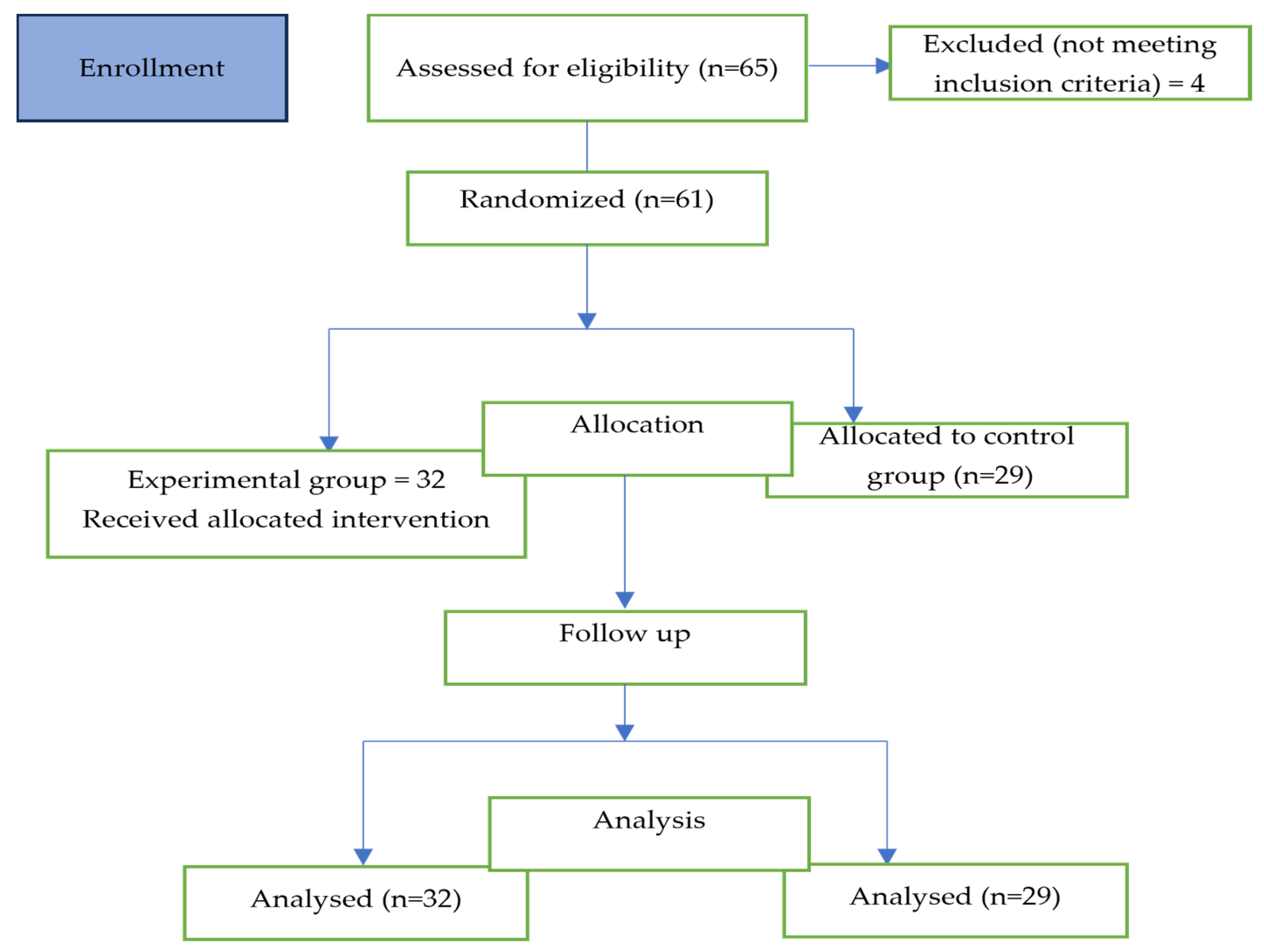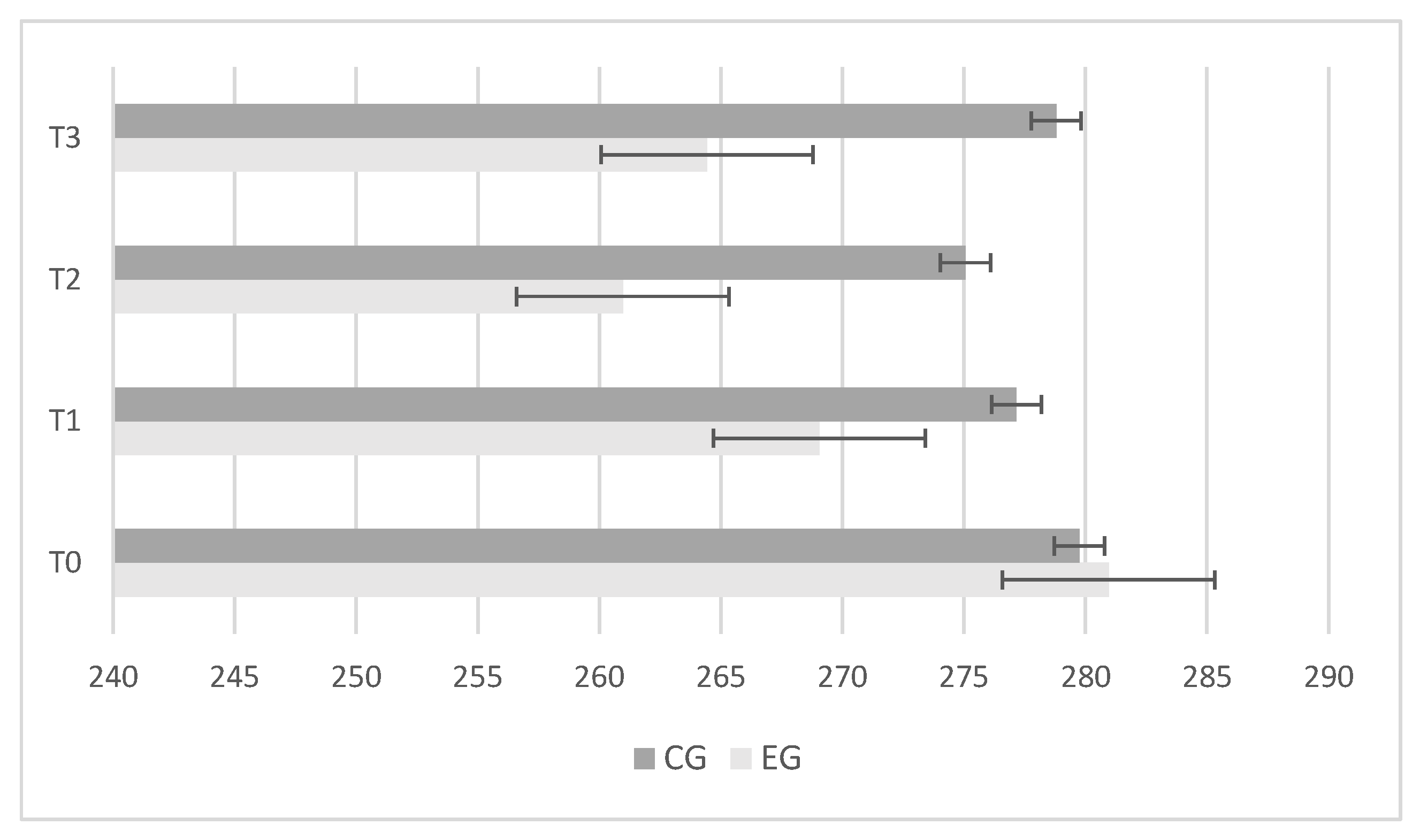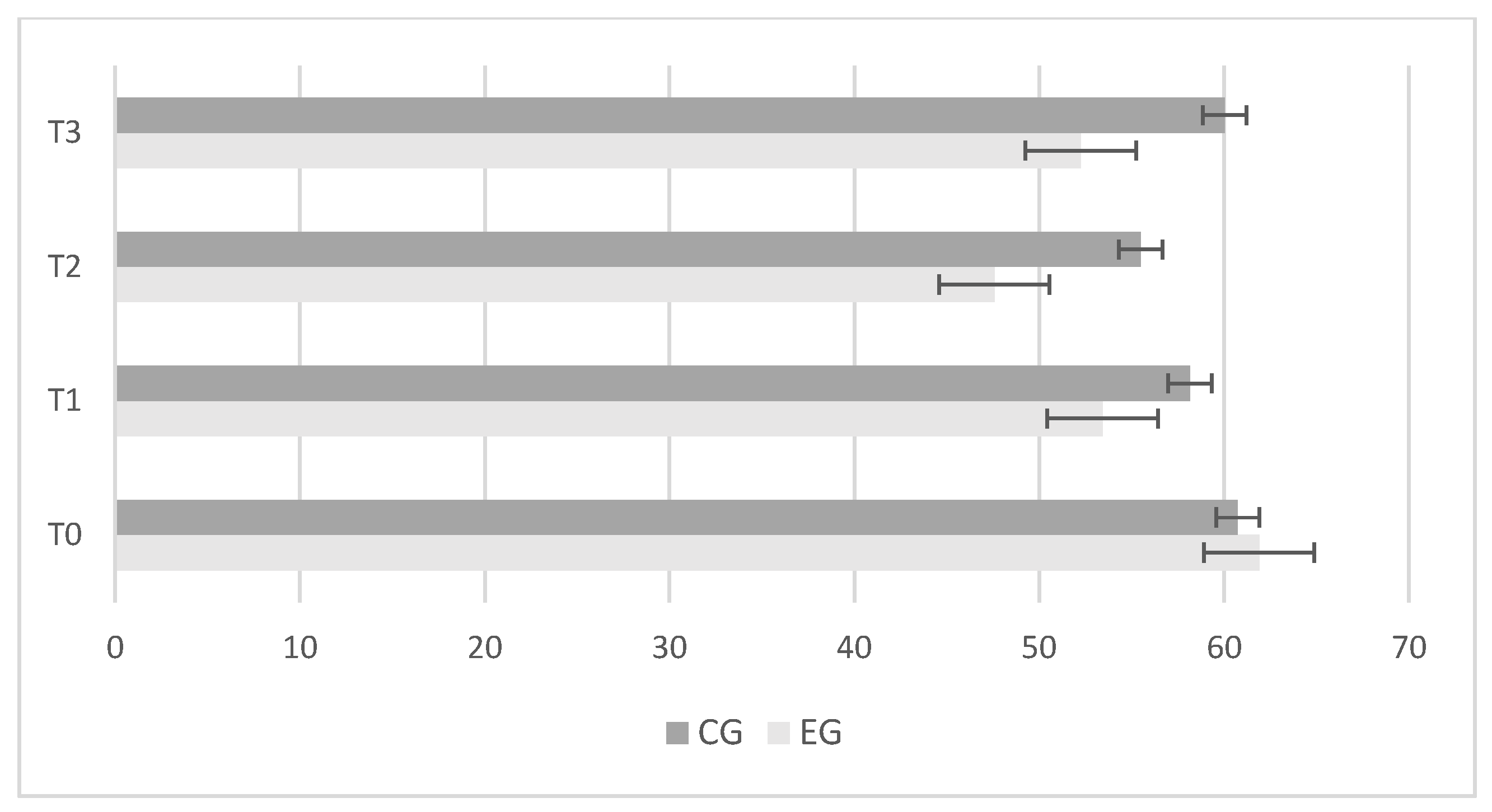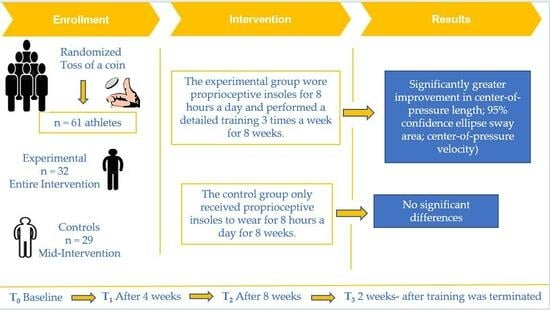Effects of Proprioceptive Insoles and Specific Core Training on Postural Stability for Preventing Injuries in Tennis
Abstract
1. Introduction
2. Materials and Methods
2.1. Participants
2.2. Procedures
2.3. Intervention
2.3.1. Core Stability Training
2.3.2. Proprioceptive Insole
2.4. Measurements
Baropodometric Platform
2.5. Statistical Analysis
3. Results
4. Discussion
5. Conclusions
Author Contributions
Funding
Institutional Review Board Statement
Informed Consent Statement
Data Availability Statement
Acknowledgments
Conflicts of Interest
References
- Lambrich, J.; Muehlbauer, T. Physical fitness and stroke performance in healthy tennis players with different competition levels: A systematic review and meta-analysis. PLoS ONE 2022, 17, e0269516. [Google Scholar] [CrossRef] [PubMed]
- Fernandez-Fernandez, J.; Ellenbecker, T.; Sanz-Rivas, D.; Ulbricht, A.; Ferrautia, A. Effects of a 6-week junior tennis conditioning program on service velocity. J. Sports Sci. Med. 2013, 12, 232–239. [Google Scholar] [PubMed]
- Fu, M.C.; Ellenbecker, T.S.; Renstrom, P.A.; Windler, G.S.; Dines, D.M. Epidemiology of injuries in tennis players. Curr. Rev. Musculoskelet. Med. 2018, 11, 1–5. [Google Scholar] [CrossRef]
- Mei, Q.; Kim, H.K.; Xiang, L.; Shim, V.; Wang, A.; Baker, J.S.; Gu, Y.; Fernandez, J. Toward improved understanding of foot shape, foot posture, and foot biomechanics during running: A narrative review. Front. Physiol. 2022, 13, 1062598. [Google Scholar] [CrossRef]
- Pluim, B.M.; Staal, J.B.; Windler, G.E.; Jayanthi, N. Tennis injuries: Occurrence, etiology, and prevention. Br. J. Sports Med. 2006, 40, 415–423. [Google Scholar] [CrossRef] [PubMed]
- Di Corrado, D.; Francavilla, V.C.; La Paglia, R.; Parisi, M.C.; Buscemi, A.; Coco, M. Short-Term Effects of Specific Sensorimotor Training on Postural Assessment in Healthy Individuals: A Pilot Study with a Randomized Placebo-Controlled Trial. J. Funct. Morphol. Kinesiol. 2023, 8, 46. [Google Scholar] [CrossRef]
- Machado, Á.S.; Bombach, G.D.; Duysens, J.; Carpes, F.P. Differences in foot sensitivity and plantar pressure between young adults and elderly. Arch. Gerontol. Geriatr. 2015, 63, 67–71. [Google Scholar] [CrossRef]
- De Blasiis, P.; Caravaggi, P.; Fullin, A.; Leardini, A.; Lucariello, A.; Perna, A.; Guerra, G.; De Luca, A. Postural stability and plantar pressure parameters in healthy subjects: Variability, correlation analysis and differences under open and closed eye conditions. Front. Bioeng. Biotechnol. 2023, 11, 1–9. [Google Scholar] [CrossRef]
- Xiang, L.; Gu, Y.; Mei, Q.; Wang, A.; Shim, V.; Fernandez, J. Automatic classification of barefoot and shod populations based on the foot metrics and plantar pressure patterns. Front. Bioeng. Biotechnol. 2022, 10, 843204. [Google Scholar] [CrossRef]
- Hillstrom, H.J.; Song, J.; Kraszewski, A.P.; Hafer, J.F.; Mootanah, R.; Dufour, A.B.; Chow, B.S.; Deland, J.T. Foot type biomechanics part 1: Structure and function of the asymptomatic foot. Gait Posture 2013, 37, 445–451. [Google Scholar] [CrossRef]
- Kovacs, M.S. Applied physiology of tennis performance. Br. J. Sports Med. 2006, 40, 381–385. [Google Scholar] [CrossRef]
- Dunsky, A. The effect of balance and coordination exercises on quality of life in older adults: A mini-review. Front. Aging Neurosci. 2019, 11, 318–328. [Google Scholar] [CrossRef]
- Barrio, E.D.; Ramirez-Campillo, R.; Garcia de Alcaraz Serrano, A.; RaquelHernandez-García, R. Effects of core training on dynamic balance stability: A systematic review and meta-analysis. J. Sports Sci. 2022, 40, 1815–1823. [Google Scholar] [CrossRef]
- Tran, T.T.; Nimphius, S.; Lundgren, L.; Secomb, J.; Farley, O.R.L.; Haff, G.G.; Newton, R.U.; Brown, L.E.; Sheppard, J.M. Effects of Unstable and Stable Resistance Training on Strength, Power, and Sensorimotor Abilities in Adolescent Surfers. Int. J. Sports Sci. Coach. 2015, 10, 899–910. [Google Scholar] [CrossRef]
- Oliva-Lozano, J.M.; Muyor, J.M. Core muscle activity during physical fitness exercises: A systematic review. Int. J. Environ. Res. Public Health 2020, 17, 4306. [Google Scholar] [CrossRef]
- Sultana, R.N.; Sabag, A.; Keating, S.E.; Johnson, N.A. The effect of low-volume high-intensity interval training on body composition and cardiorespiratory fitness: A systematic review and meta-analysis. Sports Med. 2019, 49, 1687–1721. [Google Scholar] [CrossRef] [PubMed]
- Ramirez-Campillo, R.; García-Pinillos, F.; Nikolaidis, P.T.; Clemente, F.M.; Gentil, P.; García-Hermoso, A. Body composition adaptations to lower-body plyometric training: A systematic review and meta-analysis. Biol. Sport. 2022, 39, 273–287. [Google Scholar] [CrossRef] [PubMed]
- Yaggie, J.A.; Campbell, B.M. Effects of balance training on selected skills. J. Strength Cond. Res. 2006, 20, 422–428. [Google Scholar] [PubMed]
- Hibbs, A.E.; Thompson, K.G.; French, D.; Wrigley, A.; Spears, I. Optimizing performance by improving core stability and core strength. Sports Med. 2008, 38, 995–1008. [Google Scholar] [CrossRef]
- Palmieri, R.M.; Ingersoll, C.D.; Stone, M.B.; Krause, B.A. Center-of-pressure parameters used in the assessment of postural control. J. Sport Rehabil. 2002, 11, 51–66. [Google Scholar] [CrossRef]
- Cohen, J. Statistical Power Analysis for the Behavioral Sciences, 2nd ed.; Erlbaum: Hillsdale, NJ, USA, 1988. [Google Scholar]
- Ellenbecker, T.S.; Pluim, B.; Vivier, S.; Sniteman, C. Common injuries in tennis players: Exercises to address muscular imbalances and reduce injury risk. Strength Cond. J. 2009, 31, 50–58. [Google Scholar] [CrossRef]
- Xiao, W.; Geok, S.K.; Bai, X.; Bu, T.; Norjali Wazir, M.R.; Talib, O.; Liu, W.; Zhan, C. Effect of Exercise Training on Physical Fitness Among Young Tennis Players: A Systematic Review. Front. Public Health 2022, 10, 843021. [Google Scholar] [CrossRef]
- Fernandez-Fernandez, J.; Granacher, U.; Sanz-Rivas, D.; Sarabia Marín, J.M.; Hernandez-Davo, J.L.; Moya, M. Sequencing Effects of Neuromuscular Training on Physical Fitness in Youth Elite Tennis Players. J. Strength Cond. Res. 2018, 32, 849–856. [Google Scholar] [CrossRef]
- Majewska, J.; Kolodziej-Lackorzynska, G.; Cyran-Grzebyk, B.; Szymczyk, D.; Kolodziej, K.; Wadolkowski, P. Effects of Core Stability Training on Functional Movement Patterns in Tennis Players. Int. J. Environ. Res. Public Health 2022, 19, 16033. [Google Scholar] [CrossRef]
- Wang, T.; Liu, Y.X.; Weng, Z.; Wang, S.J. Relieving patent-eligibility barriers in biotech with a preparation or treatment method. Rev. Bras. Med. Esporte 2022, 28, 651–653. [Google Scholar] [CrossRef]
- Bashir, S.F.; Nuhmani, S.; Dhall, R.; Muaidi, Q.I. Effect of core training on dynamic balance and agility among Indian junior tennis players. J. Back Musculoskelet. Rehabil. 2019, 32, 245–252. [Google Scholar] [CrossRef] [PubMed]
- Huxel Bliven, K.C.; Anderson, B.E. Core stability training for injury prevention. Sports Health 2013, 5, 514–522. [Google Scholar] [CrossRef] [PubMed]
- Ahmed, S.; Akter, R.; Saraswat, A.; Esht, V. Core stability and its impact on upper extremity function in racket sports: A narrative review. Saudi J. Sports Med. 2019, 19, 31–37. [Google Scholar] [CrossRef]
- Li, Y. Construction of intelligent campus tennis players’body data monitoring and injury warning system based on data fusion. Rev. Bras. Med. Esporte 2021, 27, 46–49. [Google Scholar] [CrossRef]
- Ivanenko, Y.; Gurfinkel, V.S. Human postural control. Front. Neurosci. 2018, 12, 171. [Google Scholar] [CrossRef] [PubMed]
- Hertel, J.; Gay, M.R.; Denegar, C.R. Differences in postural control during single-leg stance among healthy individuals with different foot types. J. Athl. Train. 2002, 37, 129–132. [Google Scholar]




The exercises have been divided into three main parts:
Phase 1: starting position: Place the roller or ball under the soleus-calf muscles with the arms resting on the ground and slide back and forth over the ball/roller. Phase 2: starting position: Place the roller or ball under the hamstrings with your arms on the ground and slide back and forth over the ball/roller. Phase 3: starting position: Place the roller or ball under the lateral thigh muscles. Find the balance position by placing the elbows on the ground and resting the foot of the leg opposite the one that is working on the ground. Perform a slide from this position. Phase 4: starting position: Sit on a chair and roll the ball along the sole of your foot. Proprioception (Series: 2—Reps: 10) Phase 1: In an upright position, place two proprioceptive half spheres under the plantar region, one under the region between the heel and the isthmus, the other between the isthmus and the forefoot. The contralateral lower limb is suspended. Phase 2: Maintain the position by checking the position of the ankle joint. |
In the upright position, carry out an eversion movement (external rotation of the foot) against muscular resistance. Posterior tibial strengthening exercise (Sets: 3—Reps: 15) Sitting on a chair, place the elastic around the sole of the foot, with the only point of contact with the ground at the heel. Make a reverse movement (turning the foot inward). Posterior tibial strengthening exercise (Sets: 3—Reps: 15) Sitting on the ground, flex one leg while extending the other, and overcome the resistance of the elastic by performing flexion-extension of the sole of the foot. Anterior tibial strengthening exercise (Sets: 3—Reps: 15) Sitting on the ground, flex one leg while extending the other, and overcome the resistance of an elastic by performing flexion-extensions of the back of the foot. Toe-toe and lateral foot walking (Sets: 3—Reps: 60 s each) Walk on your toes with your knees extended and locked for 1 min. Walk on your heels with your knees extended and locked for about 1 min. Walk on the outside of your feet without resting the soles of your feet on the ground. Mobilization of the ankle joint (Sets: 2—Reps: 5) With feet slightly apart, place the front foot approximately 15–20 cm from the wall with legs straight. From this position, sit down, soliciting the flexion-extension of the ankle joint. The heel must remain close to the floor. |
Phase 1: starting position: Stand upright facing a wall with your hands supported and your feet parallel. Slowly bend your left leg while abducting your right leg and slide back until your heel can maintain contact with the floor. As you exhale, rotate your pelvis, bringing your right hip forward and to the side. Breathe deeply and hold the position until you feel the maximum stretch. Elongation of the anterior tibialis (Sets: 2—Reps: 30 s) Phase 1: starting position: Kneel on your heels with the backs of your feet on the ground. Hold the position while breathing. Lengthening of the peronealis (Sets: 2—Reps: 30 s) Phase 1: starting position: Stand upright with your heels 60 cm apart and your lower limbs completely rotated (toes pointing inward). As you exhale, gradually bend your knees, bringing them closer together. Maintain the position with your pelvis in retroversion and your torso erect while breathing. Stretching of the flexors of the fingers (Sets: 2—Reps: 30 s) Phase 1: starting position: Squat in front of a wall with your hands resting on it. Gradually lower your knees until they just touch the floor. Breathe deeply and hold the position. |
| Groups | Age (years) | BMI (kg/m2) | Weight (kg) | Height (cm) |
|---|---|---|---|---|
| Experimental Group | 15.9 ± 1.64 (14–19) | 21.6 ± 1.12 (19.4–23.4) | 60.8 ± 2.16 (57.0–65.0) | 169 ± 2.19 (163–173) |
| Control Group | 16.2 ± 1.57 (14–19) | 21.3 ± 1.03 (19.2–23.4) | 61.6 ± 2.31 (58.0–66.0) | 169 ± 3.78 (162–174) |
| η2 | 0.23 | 0.17 | 0.21 | 0.19 |
| p | 0.85 | 0.61 | 0.73 | 0.67 |
| Postural Parameters | Group | T0 | T1 | T2 | T3 |
|---|---|---|---|---|---|
| LCoP (mm) | EG | 281 ± 28.4 | 269 ± 28.2 | 260 ± 27.6 * | 265 ± 27.8 * |
| CG | 280 ± 24.7 | 277 ± 24.9 | 275 ± 24.9 | 279 ± 25.4 | |
| ESA95% (mm2) | EG | 62 ± 9.4 | 54 ± 9.6 | 48 ± 8.9 * | 52 ± 9.1 * |
| CG | 61 ± 15.6 | 59 ± 15.5 | 55 ± 15.2 | 60 ± 15.7 | |
| VCoP (mm/s) | EG | 84 ± 6.1 | 78 ± 6.7 | 74 ± 6.5 ** | 77 ± 7.6 * |
| CG | 83 ± 4.7 | 80 ± 4.4 | 78 ± 4.6 | 81 ± 5.9 |
| Postural Parameters | t | p | Mean Difference (95%CI) | η2 | Cohen’s d | |
|---|---|---|---|---|---|---|
| LCoP (mm) | T0 | 0.17 | 0.86 | 1.20 (−12.5~14.9) | 0.09 | 0.04 |
| T1 | −1.18 | 0.24 | −8.10 (−21.8~5.7) | 0.16 | −0.30 | |
| T2 | −2.08 | 0.04 * | −14.10 (−27.7~−0.5) | 0.54 | −0.54 | |
| T3 | −2.09 | 0.04 * | −14.36 (−28~−0.7) | 0.57 | −0.54 | |
| ESA95% (mm2) | T0 | 0.356 | 0.72 | 1.16 (−5.3~7.7) | 0.07 | 0.09 |
| T1 | −1.44 | 0.15 | −4.72 (−11.2~−1.8) | 0.11 | −0.37 | |
| T | −2.50 | 0.01 * | −7.92 (−14.3~−1.6) | 0.49 | −0.65 | |
| T3 | −2.40 | 0.01 * | −7.79 (−14.2~−1.31 | 0.53 | −0.61 | |
| VCoP (mm/s) | T0 | 1.02 | 0.31 | 1.44 (−1.4~4.2) | 0.21 | 0.26 |
| T1 | −1.66 | 0.10 | −2.43 (−5.3~0.49) | 0.19 | −0.42 | |
| T2 | −2.82 | 0.001 * | −4.10 (−7.0~−1.2) | 0.77 | −0.72 | |
| T3 | −2.21 | 0.03 * | −3.87 (−7.3~−0.37) | 0.69 | −0.57 | |
Disclaimer/Publisher’s Note: The statements, opinions and data contained in all publications are solely those of the individual author(s) and contributor(s) and not of MDPI and/or the editor(s). MDPI and/or the editor(s) disclaim responsibility for any injury to people or property resulting from any ideas, methods, instructions or products referred to in the content. |
© 2024 by the authors. Licensee MDPI, Basel, Switzerland. This article is an open access article distributed under the terms and conditions of the Creative Commons Attribution (CC BY) license (https://creativecommons.org/licenses/by/4.0/).
Share and Cite
Messina, G.; Francavilla, V.C.; Lima, F.; Padua, E.; Secolo, G.; Secolo, I.; Iovane, A.; Parisi, M.C.; Di Corrado, D. Effects of Proprioceptive Insoles and Specific Core Training on Postural Stability for Preventing Injuries in Tennis. J. Funct. Morphol. Kinesiol. 2024, 9, 34. https://doi.org/10.3390/jfmk9010034
Messina G, Francavilla VC, Lima F, Padua E, Secolo G, Secolo I, Iovane A, Parisi MC, Di Corrado D. Effects of Proprioceptive Insoles and Specific Core Training on Postural Stability for Preventing Injuries in Tennis. Journal of Functional Morphology and Kinesiology. 2024; 9(1):34. https://doi.org/10.3390/jfmk9010034
Chicago/Turabian StyleMessina, Giuseppe, Vincenzo Cristian Francavilla, Francesco Lima, Elvira Padua, Giuseppe Secolo, Innocenzo Secolo, Angelo Iovane, Maria Chiara Parisi, and Donatella Di Corrado. 2024. "Effects of Proprioceptive Insoles and Specific Core Training on Postural Stability for Preventing Injuries in Tennis" Journal of Functional Morphology and Kinesiology 9, no. 1: 34. https://doi.org/10.3390/jfmk9010034
APA StyleMessina, G., Francavilla, V. C., Lima, F., Padua, E., Secolo, G., Secolo, I., Iovane, A., Parisi, M. C., & Di Corrado, D. (2024). Effects of Proprioceptive Insoles and Specific Core Training on Postural Stability for Preventing Injuries in Tennis. Journal of Functional Morphology and Kinesiology, 9(1), 34. https://doi.org/10.3390/jfmk9010034










